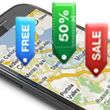by Amy Vale
There has been much talk recently about the concept of ‘geo-fencing’ and if, or when, it could come into wide-scale adoption and potentially change the mobile space for both businesses and publishers. A few weeks ago, we wrote about geo-location services and its already huge impact on location based advertising. In a similar way, geo-fencing enables retailers to recognize customers when they are in a particular location, on the go on their mobile devices. Essentially, the difference between geo-fencing and geo-location services generally is that the new technology geo-fencing actually refers to a virtually fenced-off geographic location. For example, a radius around a store or shopping mall, and people who have “opted in”, receive messages and special offers designed to encourage them to walk into the store and make an immediate purchase.
As expected, geo-fencing technology has huge potential for retailers because it can reach consumers while they are out and on the go, and while they are in the mindset to make a purchase already. Retailers and advertisers are able to send relevant and, specific messages, while taking into account where that person is, at that moment in time. The new technology has already been trialed by various retailers.
Geo-fencing got a major showcase with a roll-out in the UK through mobile operator O2, which launched a program to target a million subscribers with Starbucks and L’Oreal coupons. When customers came within about a half mile of a Starbucks store, they received a text message with a discount offer. Likewise, customers who travelled near a drug store chain received an SMS offering deals on L’Oréal products. This trial was successful because instead of relying on GPS, it established a subscriber’s location through a carrier’s network, This meant that it reached a wider market by targeting users who don’t have a smartphone or a GPS-enabled phone.
The possibilities for geo-fencing applications are endless. To get an idea of how geo-fencing technology could improve on existing location-based applications, just look at the current popular apps. Apps like Foursquare could implement this infrastructure to allow users to automatically “check-in” when entering a particular location. Another potential example of geo-fencing is connecting mobile devices to house lights or air conditioning units to automatically activate them when users approach their homes. Friends could even be notified when they are within a certain distance of one another.
Like other geo-location services, there is still the concern that the general public feels toward the technology because of the perceived “tracking” of their mobile device. Many users don’t like the idea of a retailer being able to know where they are, regardless of whether this is true or not. Nevertheless, we are expecting increasing numbers of retailers to test out geo-fencing strategies over the coming year, alongside the continued domination and expansion of the smartphone. It is going to come down to whether they can find the right balance between making users feel like they’re taking advantage of a deal, without being spammed or stalked.


Geo is becoming a very helpful tool for mobile user.
ReplyDeleteThanks
Mobile Application Development
Great information you got here. I've been reading about this topic. I found it here in your blog. I had a great time reading this.
ReplyDeleteiPhone Application Developers for hire
Impressive blog ,I never read this types of blog before. thanks to providing this type of interesting content. I’ll be waiting for your next blog.
ReplyDeleteBartow text sms marketing
Nice post! Can’t wait for the next one. Keep stuff like this coming.
ReplyDeleteAsus - 14.1" Notebook 8 GB Memory - 750 GB Hard Drive
Asus - K53SD-DS51 15.6" LED Notebook - Intel Core i5 i5-2450M 2.50 GHz - Mocha